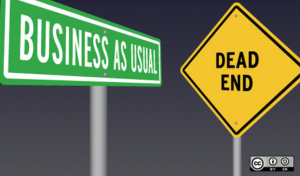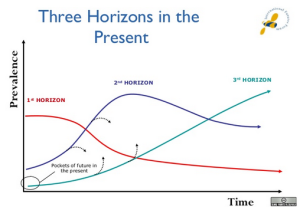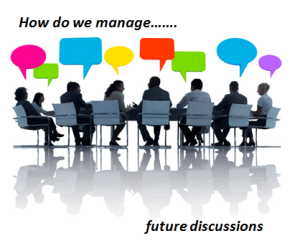 There is that prevailing sense that we are just managing the business, as usual, leaving many increasingly uncomfortable and feeling exposed to concerns over innovation in the future. Why?
There is that prevailing sense that we are just managing the business, as usual, leaving many increasingly uncomfortable and feeling exposed to concerns over innovation in the future. Why?
Our businesses are not adapting fast enough to changing conditions in the market, often lagging in the competitive race to update and keep relevant.
Businesses are struggling with conflicting knowledge flows and incoming intelligence, just simply managing their talent to keep them relevant, engaged and outwardly orientated.
They need to constantly adjust and adapt to the demands and challenges within the societal conditions, environments and markets, grappling with constant shifts in consumer demand and coping with the declining natural resources and what all of this might mean.
We are often short on foresight and certainly struggling with growing complexity.
Bill Sharpe and Tony Hodgson, along with Andrew Curry and Graham Leicester, have been working to bring the Three Horizons framework into a more widespread use .
Once I had ‘found them’ through the International Futures Forum they became the catalyst for my own perspective of exploring this framework and applying it specifically for innovation
Bill and Tony have recently provided a wonderfully descriptive view of valuing the Three Horizon Framework within a 3H slideshare deck I’d encourage you to work through. It frames and captures much that reflects the tensions and approaches to overcome these.
I’d also encourage you to go back and explore my different thoughts in this site by entering the search box: “three horizons”. My trilogy of blogs starting with “the Value of Managing Innovation Across the Three Horizons” I’d suggest is equally not a bad place to start for a clear background to this methodology.
Reflecting on a framework that can help frame those future discussions?

Let me reflect on some of the thinking around the 3H framework as I relate to it from my more dedicated focus, the innovation management perspective.
Why I so much like this 3H framework is in its value where you can construct distinctly different horizon focuses, based on the present, that allow a ‘growing future consciousness’
Our need is that we all must find ways to embrace the future, to not get simply caught up and washed away, because we were ‘just’ unable to move beyond the present, or simply stayed stuck in the past.
I think this 3H framework is very powerful to allow us to move beyond our existing framing, to map across different horizons
Often we are caught by surprise, ignoring many warning signs
With our lack of foresight and lack of actions we lose something that begins us to ‘walk the path towards decay.’ If we ignore ‘taking action’ long enough for a host of seemingly reasonable reasons when something occurs that simply confirms what we inwardly had felt for some time might possibly happen, it has already grown into a real problem.
By using our ability to use foresight; in seeing this possible set of events, different signals and warnings we have two choices. We could have chosen to continue to ignore it, or we start to make ‘investments’ into building new defences, new capabilities, new stepping-stones to the future.
There is this powerful need to look toward the future
Based on what we know today and what we can set about building and exploring does hold the exciting promise of the future. Looking out of ourselves offers a more rewarding prospect.
A future held in our own hands then we can help shape it and integrate it into our daily lives or of course, we can simply ignore it and keep hunkered down in what we do, feeling we are comfortable and secure. I would argue we all need to embrace change, not avoid it, it never goes away, it is constantly tapping you on the shoulder.
We need to keep reflecting upon what is dominant, prevalent and pattern-changing, as these positions are constantly shifting. Scanning the horizons and what is simply all-around ‘us’ offers those ‘pockets of the future to invest in, explore and experiment, to be open to change.
Initially, these pockets of the future may seem a long way off, often just really weak signals, but are indicating different, perhaps far more radical and perhaps disruptive changes and our organizations need to constantly re-equip for these by building different capabilities and competencies.
Technology clearly comes to mind with wave upon wave of change, crashing against the established rocks, beginning to weaken the existing structures and form new ones.
Just remember the present is already in decline
It is the constant renewing, the transforming and capturing of these weak signals, today clearly seen as marginal to our business, that can permit us to explore and begin to re-equip ourselves for the changes that might happen. Small investments anticipating potential changes are highly valuable to consider.
We can choose to ignore these signals or poorly underfund them as they often seem vague, often unrelated to our existing practices. They are unsure in what they bring, mostly experimental in the early investigations, that ‘seemingly’ conflict, even drawing resources away from our existing model but at what risk to the future?
The ongoing dilemma we need to also revolve, is around multiple crossover points, between blending the existing with these possible futures, allowing time and resources to figure out and explore the options these might present as future options to the business.
Not enough time really does constraint and dominate
We never can find enough time to manage all that we would like to. We are forced to (eventually) make many rushed choices, often ill-judged or last-minute, reacting to changes being forced on us.
Our interests, values, and mindset all ‘kick in’ and when it comes to discussing the future, well often initial discussions begin to move into conflict, based on established positions, types of personality, vested interests or opinions.
Attitudes and judgement are either grounded in the present, with many executives fairly dismissive of the future, or those that are more future related become increasingly impatient in wanting to challenge and change the present.
We need to manage the tensions between the different views on managing the present and the future.
The rising way of change comes from different experiments and innovations
It is partly through the treatment of innovation, feeding into the system a rising wave of future innovations that alter positions. Staying stuck in ‘just’ incremental to serve the existing conditions in the market seriously constrains you for the future, you stop growing, exploring, being curious and experimental.
Encouraging separate and focused discussions on the future is increasingly essential

Discussions within the boardroom, within our R&D centre on the breadth and depth of the future portfolio and the allocation of resources for innovation, which needs to have different mindsets within the 3H approach.
There needs to be a framework to surface different assumptions, often conflicting and entrenched views to surface the potential pockets of the future as seen through different eyes.
If we can avoid those initial, often highly personal definitive judgements of the future, we can begin to map these conflicting thoughts back to our existing, to see different emerging patterns that meet many of these seemingly ‘conflicting voices’ and each begin to appreciate and see their role of moving the existing into these futures as they make sense to their lens or orientation.
You evaluate what initiatives are already under-way, that have a more future orientation and which seemed to be more sustaining for the present. We are looking to find ways for transformational change grounded partly in the present, partly based on clear movement detected.
We are moving the ‘grounded knowledge’ and assumptions into the potentials that are thought to be emerging, we see the role of the present in the future, we can see much can be ‘let go’ and allowed to be opened up and explored differently. We are beginning to adapt to the new environment. The future might be getting clearer.
We need to take care of any future discussions.
The three horizon methodology and how you frame each of the dialogue sessions do need care. You are not only dealing with present complexity but seeing future scope through emerging patterns and many weak signals; equally, we are often dealing with entrenched positions, insecurity and impatience.
It is the ability to step back, to travel in the ambiguous territory, challenge the safe bet of extending the old system, to release these deep tensions these conversations will reveal.
I would encourage adopting the three horizon methodology for innovation
We need to encourage a transformation in our capacities by developing a collective awareness of our ‘future consciousness’ that opens up greater freedom to act and move forward.
I believe the three horizon methodology becomes an essential framework for any organization wanting to determine its resources and evaluate its innovation pathways.
Exploring the field of futures and foresight as an emerging practice
In a future post, I’d planning to discuss part of a book that came out in late 2013 by Bill Sharpe. His book, or actually more a booklet, is called “Three Horizons: The Patterning of Hope”, published by Triarchy Press.
In this book, Bill is outlining his distinct and even highly sensitive way of creatively working through many of the unknowns, by framing and connecting through the Three Horizons, offering his contribution to the patterning of hope for all our futures.
5 thoughts on “Reflecting on the Three Horizon Model for our Innovatation in the Future”
Comments are closed.